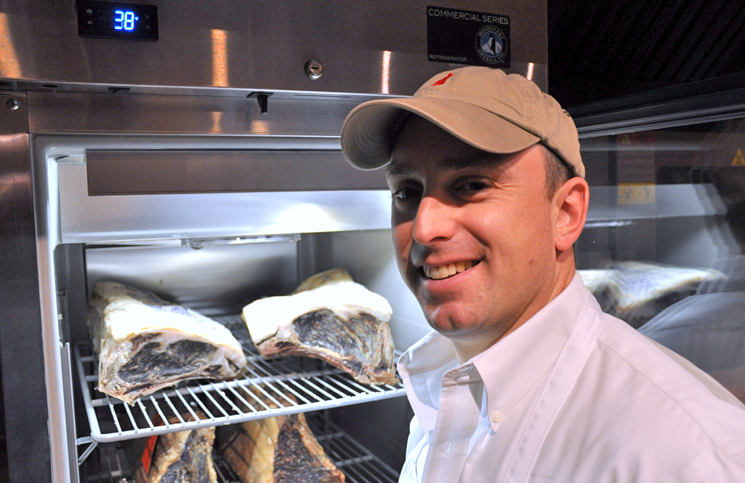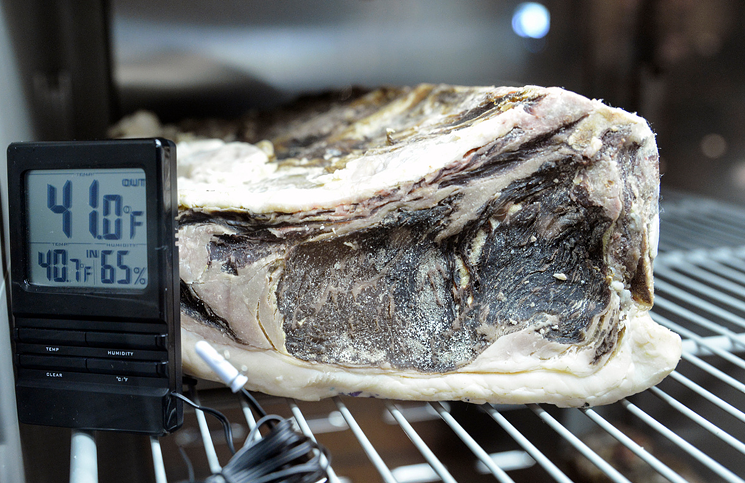There are two things most people who are well-versed in food know about dry-aged steaks.
- They’re expensive.
- They’re not cheap.
And that alone is enough to compel otherwise open-minded foodies to try something different. But the reality is that dry-aged beef (as opposed to the traditional, wet-aged beef) is becoming more approachable and accessible to the general public.
Think about your favorite grocery store. Over the past few years, a growing number of meat departments have been installing special dry-aging coolers, stocked with giant hunks of beef, aging before you. It’s those special coolers that allow for the dry-aging process to happen, and here at the Certified Angus Beef ® Education & Culinary Center, Dr. Phil Bass has his very own dry-aging cooler where he’s continually evolving the way he ages his steaks.
Think of a dry-aging cooler as a giant humidor, where steaks are held on racks in a temperature- , air flow-, and humidity-controlled environment with an aim on evaporating the moisture within the meat, leaving only immense beef flavor. In the meantime, the naturally occurring enzymes within the meat are hard at work, making the beef more tender, the longer it ages.
Once it’s aged to your liking (Bass recommends 28 days for an optimal eating experience), the butcher will trim off the hard, crusted shell that forms around the meat, and the end result is an ultra-tender, intensely flavored piece of beef that’s like nothing you’ve ever tasted.
Some describe it as a “nutty” flavor. Others define it as “earthy.”
According to Bass, dry-aged cuts from different regions will taste differently due to the variation in molds that will eventually play their part in creating additive flavors. For instance, the flora that would grow in Wooster, Ohio, is quite different than what you’d find in New York City.
“We’re constantly learning,” Bass says. “There are a lot of different ways you can do this process, but mine is a more conventional way. I put high-velocity air over the meat and rotate it as the meat matures. I also like to allow for natural light. There is UV lighting you can use, but I don’t want to kill any of the natural molds. I allow them to set up shop so they can impart their own flavors.”
If terms like “mold” and “enzymes” are upsetting to your appetite, understand that the process of dry-aging beef isn’t all that different from how artisanal cheeses are made. It’s a craft that’s been perfected over generations – just not necessarily in your neighborhood grocery store.
Metro New York-based DeBragga & Spitler is going on its third generation in the dry-aging business, and is a supplier to some of the most highly regarded restaurants in New York City.
Restaurants like Red, the Steakhouse in Miami and Cleveland, El Gaucho in Seattle, RingSide Steakhouse in Portand, and Stark’s Steakhouse in Santa Rosa, Calif., have a clientele that expects steaks to be dry-aged to perfection. And slowly but surely, grocery stores are catching on to serve their own customers.
Market District in northeast Ohio and Pittsburgh, Reasor’s in Tulsa, Schnucks in St. Louis and Longos in Toronto all have stores offering dry-aged Certified Angus Beef ® brand steaks, and surely there are many others out there.
So next time you have the opportunity to participate in a dry-aged cut of beef, take it. You don’t realize what you’ve been missing.



I’ve not had the privilege or pleasure of enjoying a dry age cut of beef. I know people who have and they have really enjoyed their meal. I appreciate this post as now I feel more understanding of the love for this meal.